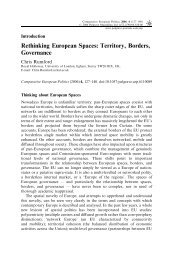Europeanisation, National Identities and Migration ... - europeanization
Europeanisation, National Identities and Migration ... - europeanization
Europeanisation, National Identities and Migration ... - europeanization
You also want an ePaper? Increase the reach of your titles
YUMPU automatically turns print PDFs into web optimized ePapers that Google loves.
228 Judit Tóth <strong>and</strong> Endre Sik<br />
The underst<strong>and</strong>ing of dispersion (as it is deducible from dispersal, the sense of the<br />
classic notion of Diaspora) as Diaspora is of particular interest, as in that case what<br />
is to be determined is the interpretation of dispersion. Compared to the ten-million<br />
strong population of Hungary, even the ethnic Hungarian blocks of Transylvania<br />
should be seen as living in dispersion.<br />
Diaspora is nothing but dispersion. Therefore I regard the block of the Székely<br />
community, even though you can travel for six hours in their midst without<br />
hearing a word of Rumanian spoken anywhere; however, because of the great<br />
distance <strong>and</strong> isolation from Hungary, this is a Diaspora. I am not here using<br />
the notion of Diaspora in its religious sense as it is used in phrases like ‘the<br />
dispersal of the Jewish Diaspora,’ neither in the sense of migration. That sense<br />
is applicable to Hungarians in the West. That is, those who emigrate from<br />
Hungary <strong>and</strong> settle down somewhere between Austria <strong>and</strong> Canada, form one<br />
Diaspora. But regarding the Hungarian Diaspora I consider dispersal in a general<br />
sense, meaning that political boundaries do not coincide with the boundaries<br />
of language <strong>and</strong> culture. Viewed from Transylvania, the Székely community<br />
is no Diaspora, the block of Hungarians in Partium is no Diaspora, but those<br />
living in Transylvania Interior or the Banat are. Viewed from Budapest,<br />
however, the Székely – in spite of their population of 600–700 thous<strong>and</strong> – are<br />
by all means a Diaspora. The whole issue depends on where you look at it<br />
from.<br />
What I mean by Diaspora is dispersion. The Hungarians of Sub-Carpathia I<br />
do not regard as Diaspora, as they do not live in dispersion. After all, the<br />
Hungarians of Sub-Carpathia live in one large block.<br />
In sum, it can be concluded that the whole of the Hungarian population living<br />
within the Carpathian Basin is not regarded as Hungary’s Diaspora by the actors<br />
of Diaspora-politics. However, a number of empirical arguments available may<br />
provide us with a sufficient basis to recommend that the nature of the connection<br />
of ethnic Hungarians across the borders <strong>and</strong> in the Carpathian Basin with Hungary<br />
(a native country that they have never left) should be considered as one possibly<br />
displaying Diasporic features.<br />
For example according to recent sociological <strong>and</strong> anthropological findings:<br />
• the symbol of Hungarian statehood (honouring the national flag) is just<br />
as important for the ethnic Hungarians of Transylvania as the statehood of<br />
Romania is for the Romanian population of Transylvania (Szakáts 1996);<br />
• for Transylvanian Hungarians living in Hungary, Hungary is ‘home away from<br />
home’ (Kántor, undated), <strong>and</strong> this dual loyalty to home survives decades<br />
(Szakáts 1996);<br />
• Hungary (although to a lesser degree, but even today) is ‘home turf’ for the<br />
ethnic Hungarians of Transylvania (Bíró 1998).



